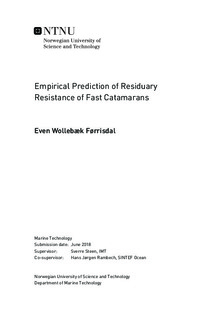Empirical Prediction of Residuary Resistance of Fast Catamarans
Master thesis
Permanent lenke
http://hdl.handle.net/11250/2564471Utgivelsesdato
2018Metadata
Vis full innførselSamlinger
- Institutt for marin teknikk [3432]
Sammendrag
This thesis focuses on resistance of fast displacement catamarans, with the purpose of developing an empirical residuary resistance estimation method based on artificial neural networks. The study builds on work carried out by Hans Jørgen Rambech, where resistance data from model trials carried out by MARINTEK from 1990 to 1997 was analysed and an empirical resistance prediction method was made. This method, named CatRES, produces conservative resistance estimations for newer designs, and SINTEF Ocean has proposed the task of including model trials carried out from 1997 to 2017, and develop an improved empirical resistance estimation method. The total data set consists of 2313 samples.
The best performing neural network found through the study was trained for 996 epochs. Through validation analysis, carried out using an independent data from University of Southampton, signs of significant overtraining was observed. Training for fewer epochs yielded better generalisation ability as the prediction error for the independent data set decreased, and 19 epochs proved to be the best number of training epochs. Prediction ability was assessed by calculating mean squared error (MSE) between predicted and correct results. MSE of 0.1135 was obtained for the SINTEF Ocean dataset, and an MSE of 0.2072 was obtained for the independent data set.
Overtraining and overfitting were avoided using built-in tools in Matlab and analysis with the independent data set. The consequence of exceeding parameter validity range was analysed, where the model predicted the general behaviour, but fails to predict residuary resistance coefficients perfectly. A missing input analysis was also carried out, where setting missing input parameters equal to SINTEF Ocean sample mean yields the best prediction ability.
